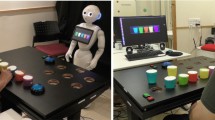Abstract
Long-term motor deficits affect approximately two thirds of stroke survivors, reducing their quality of life. An effective rehabilitation therapy requires intense and repetitive training, which is resource demanding. Virtual Agents (VAs) and Socially Assistive Robots (SARs) offer high intensity, repetitive and reproducible therapy and are thus both promising as rehabilitation tools. In this paper, we compare a SAR and a VA during a rehabilitation task in terms of users’ engagement and movement performance, while leveraging neuroscientific methods to investigate potential differences at the neural level. Results show that our participants’ performance on the exercise was higher with a SAR than with a VA, which was especially clear under conditions of decreased perceptual information. Our participants reported higher levels of engagement with the SAR. Taken together, we provide evidence that SARs are a favorable alternative to VAs as rehabilitation tools.
V. Vasco and C. Willemse—Contributed equally to this manuscript.
Access this chapter
Tax calculation will be finalised at checkout
Purchases are for personal use only
Similar content being viewed by others
References
Lawrence, E.S., et al.: Estimates of the prevalence of acute stroke impairments and disability in a multiethnic population. Stroke 5, 1279–1284 (2001)
Carlsson, H., et al.: SENSory re-learning of the UPPer limb after stroke (SENSUPP): study protocol for a pilot randomized controlled trial. Trials 19(1), 229 (2018)
Feil-Seifer, D., Mataric, M.J.: Defining socially assistive robotics. In: Proceedings of the 2005 IEEE 9th International Conference on Rehabilitation Robotics, pp. 465–468 (2005)
Schneider, S., Kummert, F.: Comparing the effects of social robots and virtual agents on exercising motivation. In: Ge, S.S. (ed.) ICSR 2018. LNCS (LNAI), vol. 11357, pp. 451–461. Springer, Cham (2018). https://doi.org/10.1007/978-3-030-05204-1_44
Fasola, J., Mataric, M.: Comparing physical and virtual embodiment in a socially assistive robot exercise coach for the elderly. Technical report, CRES–11–003 (2011)
Brooks, D., Chen, Y., Howard, A.: Simulation versus embodied agents: does either induce better human adherence to physical therapy exercise? In: Proceedings of the IEEE International Conference on Biomedical Robotics and Biomechatronics, pp. 1715–1720 (2012)
Mataric, M., et al.: Socially assistive robotics for stroke and mild TBI rehabilitation. Stud. Health Technol. Inform. 145, 249–262 (2009)
Fiol-Roig, G., et al.: The intelligent butler: a virtual agent for disabled and elderly people assistance. In: Corchado, J.M., Rodríguez, S., Llinas, J., Molina, J.M. (eds.) International Symposium on Distributed Computing and Artificial Intelligence 2008. Advances in Soft Computing, vol. 50, pp. 375–384. Springer, Heidelberg (2008). https://doi.org/10.1007/978-3-540-85863-8_44
Arip, E.S.M., et al.: Virtual reality rehabilitation for stroke patients: recent review and research issues. AIP Conf. Proc. 1905, 050007 (2017). https://doi.org/10.1063/1.5012226
Li, J.: The benefit of being physically present: a survey of experimental works comparing copresent robots, telepresent robots and virtual agents. Int. J. Hum Comput Stud. 77, 23–37 (2015)
Cao, Z., et al.: OpenPose: realtime multi-person 2D pose estimation using Part Affinity Fields, arXiv preprint arXiv:1812.08008 (2018)
Parmiggiani, A., et al.: The design and validation of the R1 personal humanoid. In: 2017 IEEE/RSJ International Conference on Intelligent Robots and Systems (IROS), pp. 674–680 (2017)
Chevalier, G.: LSTMs for human activity recognition (2016). https://github.com/guillaume-chevalier/LSTM-Human-Activity-Recognition
Sidner, C.L., et al.: Explorations in engagement for humans and robots. Artif. Intell. 166(1–2), 140–164 (2005)
Hall, J., et al.: Perception of own and robot engagement in human–robot interactions and their dependence on robotics knowledge. Rob. Auton. Syst. 62(3), 392–399 (2014)
Hobson, H.M., Bishop, V.M.: The interpretation of mu suppression as an index of mirror neuron activity: past, present and future. Roy. Soc. Open Sci. 4(3) (2017)
Rossi, S., et al.: Socially assistive robot for providing recommendations: comparing a humanoid robot with a mobile application. Int. J. Soc. Rob. 10, 265–278 (2018)
Acknowledgments
This project is funded by the Joint Lab between IIT and Fondazione Don Carlo Gnocchi Onlus and by the Minded Program - Marie Skłodowska-Curie grant agreement No. 754490 (fellowship awarded to Pauline Chevalier). The authors thank Nina Hinz and Serena Marchesi for their assistance with data collection.
Author information
Authors and Affiliations
Corresponding authors
Editor information
Editors and Affiliations
Rights and permissions
Copyright information
© 2019 Springer Nature Switzerland AG
About this paper
Cite this paper
Vasco, V. et al. (2019). Train with Me: A Study Comparing a Socially Assistive Robot and a Virtual Agent for a Rehabilitation Task. In: Salichs, M., et al. Social Robotics. ICSR 2019. Lecture Notes in Computer Science(), vol 11876. Springer, Cham. https://doi.org/10.1007/978-3-030-35888-4_42
Download citation
DOI: https://doi.org/10.1007/978-3-030-35888-4_42
Published:
Publisher Name: Springer, Cham
Print ISBN: 978-3-030-35887-7
Online ISBN: 978-3-030-35888-4
eBook Packages: Computer ScienceComputer Science (R0)




